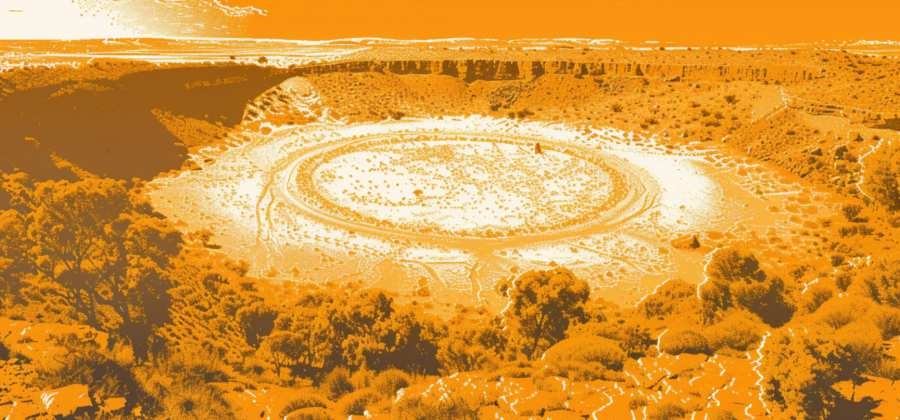Wolfe Creek Crater: Exploring a Meteorite's Impact in Australia

A Meeting of "The Gods Must Be Crazy" and Crocodile DundeePicture this: a massive fireball is hurtling through the outback sky, carelessly disregarding the welfare of any kangaroos, emus, or drop bears that might be minding their own business down below. As it smashes into Earth with a force equivalent to 500,000 tonnes of TNT, the nearby wildlife nervously wonders if this is what they get for not voting in the last election. And thus, the Wolfe Creek Crater is born in the remote deserts of Western Australia, some 300,000 years ago. Keep this in mind next time you're running late for a meeting or your Netflix connection is down – things could be worse; you could be on the receiving end of a celestial temper tantrum.
Discovery: A Well-Hidden PockmarkDespite its size – 875 meters in diameter and almost 60 meters deep – Wolfe Creek Crater was not discovered by us silly humans until 1947. Perhaps it's just as well, considering the general chaos we tend to spread wherever we go. In any case, the crater was finally noticed during an aerial survey, and eager geologists ventured to the site in 1956. Though the thought that scientists spent nine years debating whether they could be bothered to explore the crater is amusing, it's more likely that they were busy with other pressing matters, such as, well, who can say? We're not geologists.
It's worth noting that the local Aboriginal people, the Djaru, were well aware of the crater long before the arrival of the white man. They called it "Kandimalal" and attributed its creation to a mythological battle between two serpents. Though this might not hold up to scientific scrutiny, it's about a million times cooler than saying, "Oh yes, it's a meteorite impact crater."
Wolfe Creek Crater: A Tourist Attraction for the FearlessWolfe Creek Crater is a bit like the Monty Python of geological formations – it's there, it's spectacular in a bizarre sort of way, but not everybody appreciates it. In fact, it's so remote that you're more likely to encounter a pack of wild camels (yes, camels in Australia – more on that later) than other human beings. But if you're the sort who relishes the opportunity to visit the site of an ancient cataclysmic event, this is the place for you.
Getting to Wolfe Creek Crater can be an adventure in and of itself. The closest town, Halls Creek, is about 150 km away. From there, you can drive along the Tanami Road, which is not so much a road as a vague suggestion of where your tires should go. Four-wheel drive is highly recommended, as is a very patient and understanding GPS system.
Once you reach the crater, you'll be rewarded with a landscape that looks like it was designed by Dr. Seuss. The crater itself is filled with an assortment of vegetation, including spinifex, shrubs, and even eucalyptus trees, making it a veritable garden of otherworldly delights. The rim, on the other hand, is a barren and rocky place, perfect for practicing your moonwalk (and we mean the dance move, not the astronaut thing).
The Wild Camels of the OutbackNow, about those camels. Contrary to popular belief, Australia isn't just about kangaroos, koalas, and various creatures that can kill you in the blink of an eye. It also boasts a thriving population of feral camels, who were initially imported during the 19th century to help in the construction of railways and other infrastructure. Once their services were no longer needed, the camels were released into the wild, where they found the outback to their liking and flourished. Today, their numbers are estimated to be between 1 and 1.2 million, which makes them the largest population of wild camels in the world.
While they may not have played a significant role in the formation of Wolfe Creek Crater, those wayward camels do tend to frequent the area. So if you're ever lucky enough to pay a visit to this remarkable geological marvel, keep an eye out for the humped denizens of the desert. And give them a friendly wave – they may be just as surprised to see you as you are to see them.
In Conclusion: The Australian Outback – Land of Meteorites and CamelsWolfe Creek Crater is a testament to the power of cosmic events and the relentless passage of time. It's also a reminder of just how vast and diverse our little planet can be. So if you ever find yourself trekking through the deserts of Western Australia, with a sense of adventure and a sturdy vehicle, consider making a detour to this incredible site. You'll be rewarded with a once-in-a-lifetime experience, stunning views, and possibly even some camel sightings. Just remember to pack plenty of sunscreen and a sense of humor – you're going to need them.
|
|







